Liver Cancer
Background
An estimated 3,300 Canadians will be diagnosed with liver cancer annually [1] and only 19% of those diagnosed will survive for at least 5 years [2]. Liver cancer is often diagnosed in later stages and there are currently no recommended screening tests. Early-stage tumours can also be harder to identify during a routine physical exam as most of the liver is covered by the rib cage [3].
The most common risk factors associated with liver cancer are smoking, alcohol consumption, aflatoxins, hepatitis B and C infection, liver cirrhosis, obesity, and type 2 diabetes [4]. Occupational exposures may also play an important role in the development of liver cancer.
Known occupational exposures:
-
- Aflatoxins [5]
- Vinyl chloride monomer [5]
Suspected occupational exposures:
-
- Arsenic and inorganic arsenic compounds [5]
- DDT (4,4’-dichlorodiphenyltrichlororethane) [5]
- Trichloroethylene [5]
- N-nitrosamines [6]
- Dichloromethane (Methylene chloride) [7-8]
Key Findings
Liver cancer results in the Occupational Disease Surveillance System (ODSS) include intrahepatic bile duct cancer because of its proximity to the liver. Increased risks of liver cancer were observed among workers in agriculture, chemical, and metal sectors in the ODSS. These groups of workers may be exposed to various exposures that put them at increased risk.
Agriculture
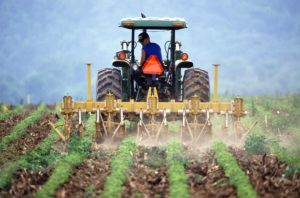 Agriculture workers demonstrated increased risks of developing liver cancer in the ODSS. Arsenical pesticides are no longer permitted in Canada with few exceptions [9-10]. Historical exposure to arsenical pesticides and DDT in farmers may have increased their risk of liver cancer [5, 11]. Aflatoxins are not suspected to contribute to liver cancer in Canadian agriculture workers. The molds that aflatoxins come from thrive in warmer and more tropical climates [12].
Agriculture workers demonstrated increased risks of developing liver cancer in the ODSS. Arsenical pesticides are no longer permitted in Canada with few exceptions [9-10]. Historical exposure to arsenical pesticides and DDT in farmers may have increased their risk of liver cancer [5, 11]. Aflatoxins are not suspected to contribute to liver cancer in Canadian agriculture workers. The molds that aflatoxins come from thrive in warmer and more tropical climates [12].
-
- Livestock and livestock combination farms: 1.72 times the risk
- Other crop and livestock combination farms: 1.23 times the risk
- Miscellaneous specialty farms: 1.15 times the risk
- Foremen: other farming, horticultural and animal husbandry: 1.44 times the risk
- Nursery and related workers: 1.29 times the risk
Chemical manufacturing industries
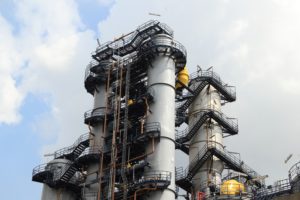 1,2-Dichloropropane can be found in paint strippers and varnishes and has been identified by the International Agency for Research on Cancer (IARC) as a known cause of bile duct cancer [5]. Similarly, dichloromethane is used as a paint stripper and metal degreaser [13]. N-nitrosamines are used as stabilizers in plastics and in rubber and tire manufacturing processes [6]. Workers in the plastics industry may be exposed to vinyl chloride monomer which is used to make polyvinyl chloride (PVC). Exposure to vinyl chloride increases the risk of developing hepatic angiosarcoma (a rare form of liver cancer) and hepatocellular carcinoma (primary liver cancer) [14].
1,2-Dichloropropane can be found in paint strippers and varnishes and has been identified by the International Agency for Research on Cancer (IARC) as a known cause of bile duct cancer [5]. Similarly, dichloromethane is used as a paint stripper and metal degreaser [13]. N-nitrosamines are used as stabilizers in plastics and in rubber and tire manufacturing processes [6]. Workers in the plastics industry may be exposed to vinyl chloride monomer which is used to make polyvinyl chloride (PVC). Exposure to vinyl chloride increases the risk of developing hepatic angiosarcoma (a rare form of liver cancer) and hepatocellular carcinoma (primary liver cancer) [14].
-
- Chemical and chemical products manufacturing industry: 1.13 times the risk
- Paint and varnish manufacturers: 1.74 times the risk
- Manufacturers of soap and cleaning compounds: 2.54 times the risk
- Miscellaneous chemical industries: 1.19 times the risk
- Chemicals, petroleum, rubber, plastic, and related materials processing: Mixing and blending occupations, chemicals and related materials: 1.14 times the risk
- Chemical and chemical products manufacturing industry: 1.13 times the risk
Metal manufacturing industries
 Working in metal manufacturing industries can expose workers to many toxic chemicals and organic solvents such as arsenic, n-nitrosamines, and trichloroethylene [6, 15-16]. Arsenic is used in the manufacture of alloys [17]. Workers in metal fabricating and machining can be exposed to straight metalworking fluids which is used to cool or lubricate metal workpieces and has been associated with bile duct cancer [18]. N-nitrosamines are used as additives to soluble and synthetic metalworking fluids [6]. Trichloroethylene was used before the 1990s as a metal degreaser [16].
Working in metal manufacturing industries can expose workers to many toxic chemicals and organic solvents such as arsenic, n-nitrosamines, and trichloroethylene [6, 15-16]. Arsenic is used in the manufacture of alloys [17]. Workers in metal fabricating and machining can be exposed to straight metalworking fluids which is used to cool or lubricate metal workpieces and has been associated with bile duct cancer [18]. N-nitrosamines are used as additives to soluble and synthetic metalworking fluids [6]. Trichloroethylene was used before the 1990s as a metal degreaser [16].
-
- Primary metals:
- Aluminum rolling, casting, and extruding: 2.32 times the risk
- Metal rolling, casting, and extruding, not elsewhere classified: 1.37 times the risk
- Metal fabricating:
- Fabricated structural metal: 1.13 times the risk
- Ornamental and architectural metal: 1.44 times the risk
- Metal stamping, pressing, and coating: 1.23 times the risk
- Hardware, tool, and cutlery: 1.21 times the risk
- Heating equipment: 1.52 times the risk
- Machine shops: 1.13 times the risk
- Machinery:
- Commercial refrigeration and air conditioning equipment: 1.25 times the risk
- Primary metals:
Other findings
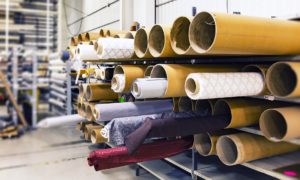 Elevated risks of liver cancer were also found in other manufacturing industries. Textile and clothing manufacturing may expose workers to tetrachloroethylene, another organic solvent used in textile processing to remove oils from fabrics and used as a finisher on some fabrics [16]. Screen printers sometimes use dichloromethane as a solvent to clean used print rolls [19]. Exposure to trichloroethylene may also be possible as it was initially used as an organic solvent in aircraft manufacturing and later replaced by perchloroethylene [20]. Other metal degreasers such as trichloroethylene and perchloroethylene can also be found in dry cleaning chemicals and have been shown to increase risk of liver cancer [21]. Risk factors among other groups in the ODSS with excess risk remain unclear.
Elevated risks of liver cancer were also found in other manufacturing industries. Textile and clothing manufacturing may expose workers to tetrachloroethylene, another organic solvent used in textile processing to remove oils from fabrics and used as a finisher on some fabrics [16]. Screen printers sometimes use dichloromethane as a solvent to clean used print rolls [19]. Exposure to trichloroethylene may also be possible as it was initially used as an organic solvent in aircraft manufacturing and later replaced by perchloroethylene [20]. Other metal degreasers such as trichloroethylene and perchloroethylene can also be found in dry cleaning chemicals and have been shown to increase risk of liver cancer [21]. Risk factors among other groups in the ODSS with excess risk remain unclear.
-
- Clothing manufacturing: 1.85 times the risk
- Textile manufacturing: 1.13 times the risk
- Man-made fibre, yarn, and cloth mills: 1.23 times the risk
- Carpet, mat, and rug: 1.24 times the risk
- Commercial printing: 1.21 times the risk
- Transportation equipment:
- Aircraft and aircraft parts: 1.39 times the risk
- Truck body and trailer: 1.32 times the risk
- Motor vehicle parts and accessories: 1.28 times the risk
- Railroad rolling stock: 1.73 times the risk
- Laundry, cleaning, and pressing service: 1.52 times the risk
- Janitors, charworkers, and cleaning: 1.22 times the risk
Relative Risk by Industry and Occupation
Figure 1. Risk of liver cancer diagnosis among workers employed in each industry group relative to all others, Occupational Disease Surveillance System (ODSS), 1999-2016
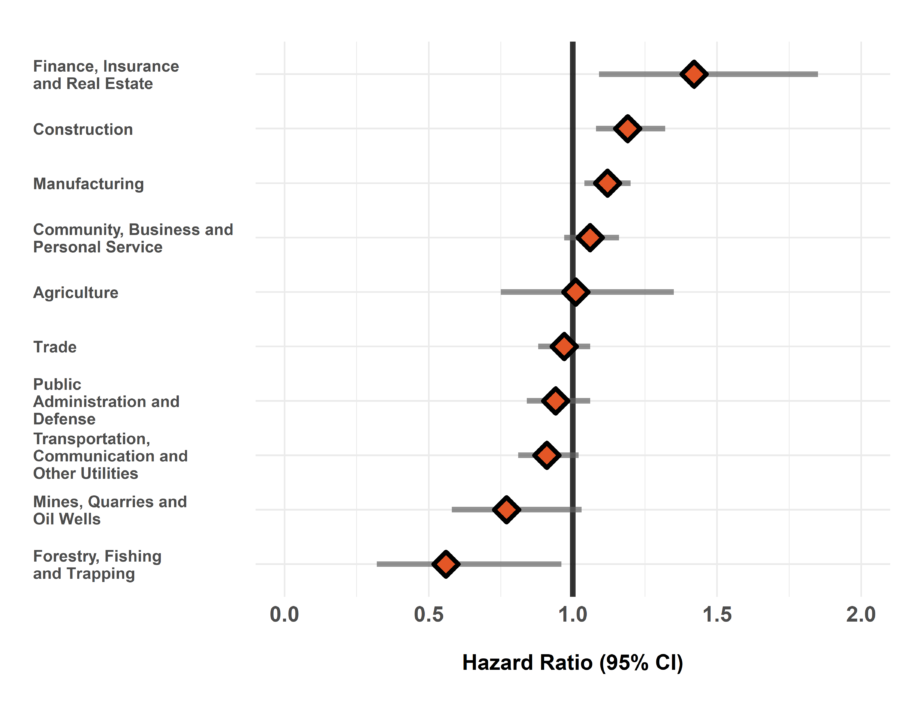
The hazard ratio is an estimate of the average time to diagnosis among workers in each industry/occupation group divided by that in all others during the study period. Hazard ratios above 1.00 indicate a greater risk of disease in a given group compared to all others. Estimates are adjusted for birth year and sex. The width of the 95% Confidence Interval (CI) is based on the number of cases in each group (more cases narrows the interval).
Figure 2. Risk of liver cancer diagnosis among workers employed in each occupation group relative to all others, Occupational Disease Surveillance System (ODSS), 1999-2016
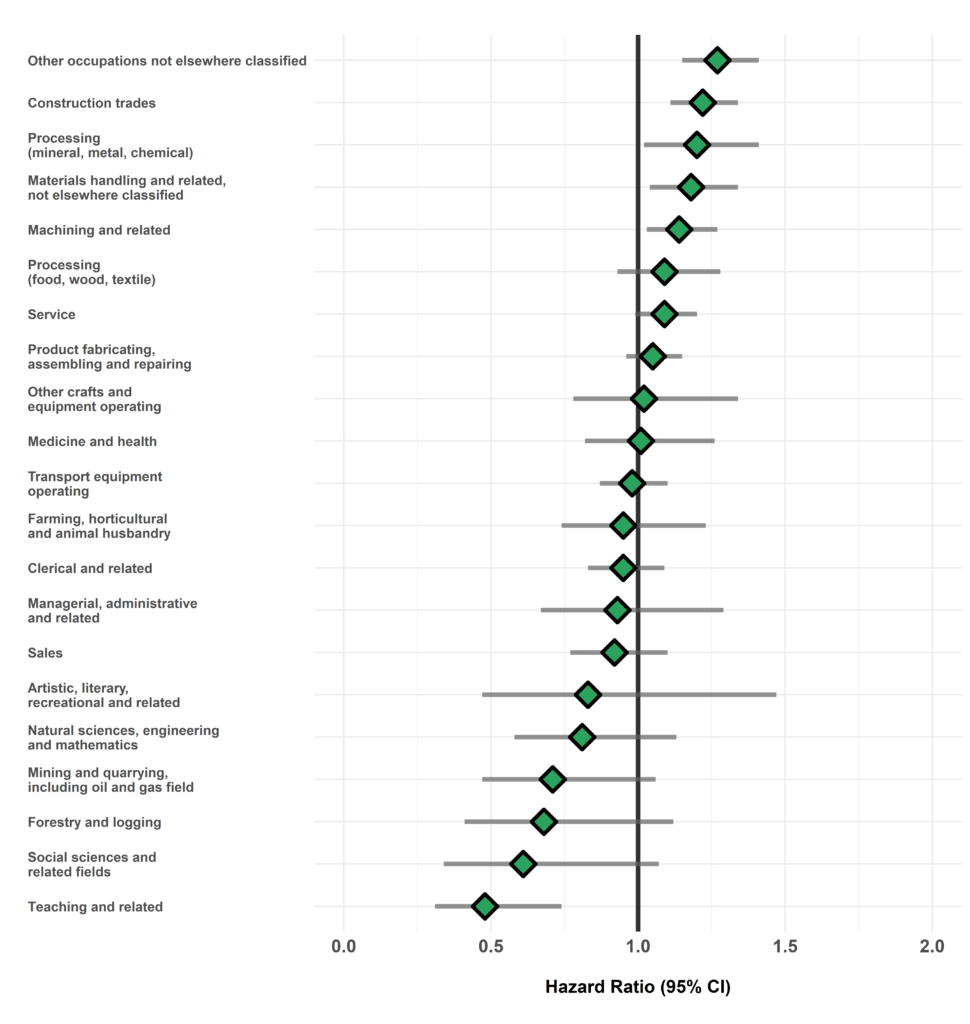
The hazard ratio is an estimate of the average time to diagnosis among workers in each industry/occupation group divided by that in all others during the study period. Hazard ratios above 1.00 indicate a greater risk of disease in a given group compared to all others. Estimates are adjusted for birth year and sex. The width of the 95% Confidence Interval (CI) is based on the number of cases in each group (more cases narrows the interval).
Table of Results
Table 1. Surveillance of Liver Cancer: Number of cases, workers employed, and hazard ratios in each industry (SIC)
| SIC Code * | Industry Group | Number of cases | Number of workers employed | Hazard Ratio (95% CI) † |
| 1 | Agriculture | 45 | 35016 | 1.01 (0.75-1.35) |
| 2/3 | Forestry, Fishing and Trapping | 13 | 10699 | 0.56 (0.32-0.96)* |
| 4 | Mines, Quarries and Oil Wells | 46 | 23210 | 0.77 (0.58-1.03) |
| 5 | Manufacturing | 1340 | 693664 | 1.12 (1.04-1.20)** |
| 6 | Construction | 450 | 211012 | 1.19 (1.08-1.32)*** |
| 7 | Transportation, Communication and Other Utilities | 326 | 197244 | 0.91 (0.81-1.02) |
| 8 | Trade | 527 | 429315 | 0.97 (0.88-1.06) |
| 9 | Finance, Insurance and Real Estate | 56 | 23993 | 1.42 (1.09-1.85)** |
| 10 | Community, Business and Personal Service | 625 | 599690 | 1.06 (0.97-1.16) |
| 11 | Public Administration and Defense | 301 | 190917 | 0.94 (0.84-1.06) |
| * SIC: Standard Industrial Classification (1970) | ||||
| † Hazard rate in each group relative to all others | ||||
Table 2. Surveillance of Liver Cancer: Number of cases, workers employed, and hazard ratios in each occupation (CCDO) group
| CCDO Code * | Occupation Group | Number of cases | Number of workers employed | Hazard Ratio (95% CI) † |
| 11 | Managerial, administrative and related | 36 | 31006 | 0.93 (0.67-1.29) |
| 21 | Natural sciences, engineering and mathematics | 35 | 26348 | 0.81 (0.58-1.13) |
| 23 | Social sciences and related fields | 12 | 30717 | 0.61 (0.34-1.07) |
| 25 | Religion | 0 | 128 | — |
| 27 | Teaching and related | 21 | 48492 | 0.48 (0.31-0.74)*** |
| 31 | Medicine and health | 95 | 135375 | 1.01 (0.82-1.26) |
| 33 | Artistic, literary, recreational and related | 12 | 14997 | 0.83 (0.47-1.47) |
| 41 | Clerical and related | 222 | 197372 | 0.95 (0.83-1.09) |
| 51 | Sales | 126 | 148148 | 0.92 (0.77-1.10) |
| 61 | Service | 481 | 370938 | 1.09 (0.99-1.20) |
| 71 | Farming, horticultural and animal husbandry | 62 | 50152 | 0.95 (0.74-1.23) |
| 73 | Fishing, hunting, trapping and related | <5 | 558 | — |
| 75 | Forestry and logging | 15 | 10684 | 0.68 (0.41-1.12) |
| 77 | Mining and quarrying, including oil and gas field | 23 | 13044 | 0.71 (0.47-1.06) |
| 81 | Processing (mineral, metal, chemical) |
155 | 79245 | 1.20 (1.02-1.41)* |
| 82 | Processing (food, wood, textile) |
156 | 99254 | 1.09 (0.93-1.28) |
| 83 | Machining and related | 416 | 189450 | 1.14 (1.03-1.27)* |
| 85 | Product fabricating, assembling and repairing | 629 | 328359 | 1.05 (0.96-1.15) |
| 87 | Construction trades | 518 | 215627 | 1.22 (1.11-1.34)*** |
| 91 | Transport equipment operating | 322 | 168138 | 0.98 (0.87-1.10) |
| 93 | Materials handling and related, not elsewhere classified | 275 | 153069 | 1.18 (1.04-1.34)** |
| 95 | Other crafts and equipment operating | 54 | 28309 | 1.02 (0.78-1.34) |
| 99 | Other occupations not elsewhere classified | 416 | 215279 | 1.27 (1.15-1.41)*** |
| * CCDO: Canadian Classification Dictionary of Occupations (1971) | ||||
| † Hazard rate in each group relative to all others | ||||
Please note that ODSS results shown here may differ from those previously published or presented. This may occur due to changes in case definitions, methodological approaches, and the ongoing nature of the surveillance cohort.
References
- Canadian Cancer Society. Liver Cancer Statistics [Internet]. [cited 2022 Mar 28].
- Canadian Cancer Society. Survival statistics for liver cancer [Internet]. [cited 2022 Mar 28].
- American Cancer Society. Can Liver Cancer Be Found Early? [Internet]. [cited 2022 Mar 28].
- Singh AK, Kumar R, Pandey AK. Hepatocellular Carcinoma: Causes, Mechanism of Progression and Biomarkers. Curr Chem Genom and Transl Med. 2018, Jun 29;12:9.
- International Agency for Research on Cancer (IARC). List of Classifications by cancer sites with sufficient or limited evidence in humans, IARC Monographs Volumes 1-127 (2021).
- Rapisarda V, Loreto C, Malaguarnera M, et al. Hepatocellular carcinoma and the risk of occupational exposure. World J Hepatol. 2016, May 8;8(13):573–590.
- Lanes SF, Cohen A, Rothman KJ, et al. Mortality of cellulose fiber production workers. Scand J Work Env Hea. 1990 Aug 1:247-51.
- Schlosser PM, Bale AS, Gibbons CF, et al. Human health effects of dichloromethane: key findings and scientific issues. Environ Health Persp. 2015 Feb;123(2):114-119.
- CAREX Canada. Arsenic and Arsenic Compounds Profile [Internet]. [cited 2022 May 4].
- Health Canada. Guidelines for Canadian Drink Water Quality: Guideline Technical Document- Arsenic. 2006.
- VoPham T, Bertrand KA, Hart JE, et al. Pesticide exposure and liver cancer: a review. Cancer Cause Control. 2017, Mar; 28(3):177-190.
- Canadian Food Inspection Agency. 2016 Children’s Food Project- Annual Report. 2016.
- International Agency for Research on Cancer (IARC). Re-evaluation of Some Organic Chemicals, Hydrazine and Hydrogen Peroxide. IARC Monographs on the Evaluation of Carcinogenic Risks to Humans Vol. 71 (1999).
- Canadian Cancer Society. Risks for liver cancer [Internet]. [cited 2022 Mar 28].
- Houten L, Sonnesso G. Occupational exposure and cancer of the liver. Arch Environ Health. 1980 Jan 1;35(1):51-3.
- IARC Working Group on the Evaluation of Carcinogenic Risks to Humans. Trichloroethylene, Tetrachloroethylene, and Some Other Chlorinated Agents. IARC Monographs on the Evaluation of Carcinogenic Risks to Humans, Vol. 106 (2014).
- International Agency for Research on Cancer (IARC). Arsenic, Metals, Fibres, and Dusts. IARC Monographs on the Evaluation of Carcinogenic Risks to Humans Vol. 100C (2012).
- Bardin JA, Gore RJ, Wegman DH, et al. Registry-based case—control studies of liver cancer and cancers of the biliary tract nested in a cohort of autoworkers exposed to metalworking fluids. Scand J Work Env Hea. 2005 Jun 1:205-11.
- Kawai T, Sakurai H, Ikeda M. Biological monitoring of occupational exposure to dichloromethane by means of urinalysis for un-metabolized dichloromethane. Ind Health. 2020, Feb 4;58(1):22-25.
- Boice JD, Marano DE, Fryzek JP, et al. Mortality among aircraft manufacturing workers. Occup Environ Med. 1999 Sep 1;56(9):581-97.
- Vlaanderen J, Straif K, Pukkala E, et al. Occupational exposure to trichloroethylene and perchloroethylene and the risk of lymphoma, liver, and kidney cancer in four Nordic countries. Occup Environ Med. 2013 Jun 1;70(6):393-401.
